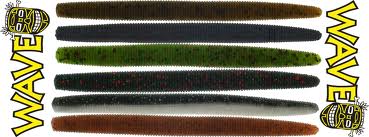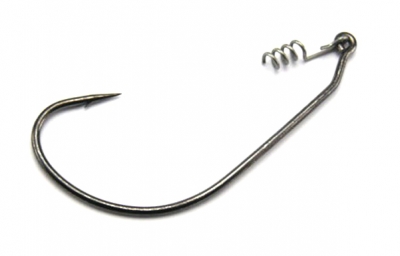by BASS member Pete Brown of Bass Lure Basics
Soft plastic lures have increased massively in popularity. These lures are made from soft synthetic materials similar to the traditional jelly worms used in Pollock fishing. There are a variety of different shapes and they can be fished in many different ways using many different tackle choices. For the purpose of this guide we are only going to discuss fishing one worm type soft plastic and one paddle tail type using weighted jig heads. However there is massive scope in this type of lure fishing and it is definitely worth investigating further.
The lures can be fished on jig heads which can be set with normal hooks or with weed less hooks, which are much less likely to snag. Retrieves vary from very slow bumps along the bottom, sink and draw style retrieves to matching the retrieve types of hard bodied lures including surface lures.
But the lure of the year (2012) for me by far has been the Wave Fishing 5” Bamboo stick.

This is a straight worm shape soft plastic that has a surprising amount of density and weight. I bought these when looking for something that I could fish weedless and weightless but still be able to cast on my normal plugging rod. They weigh 12 grams but to be honest they feel much heavier.
The real surprise though is when you actually cast them. Weedless and weightless they will cast just about as well as your regular hard lures. The hooks I have been using when fishing weightless are these:

Fished weightless the lure will fall very slowly and reasonably flat. A medium to fast retrieve will bring the lure back up to the surface. Jerks of the rod tip make the lure dart erratically and usually swim up as well. It is well worth having a mess about in some clear water where you can watch how it is behaving.
They seem to work in a load of different situations. I’ve tried to describe a few ways I use them below:
In daylight, with relatively calm conditions I will retrieve fairly slowly, with taps of my rod tip to make it almost walk the dog underwater. I will also stick plenty of pauses in there.
In daylight or night time with rough conditions I will just cast it out there and just try to keep in contact. The lure will get buffeted about all over the place but the Bass seem to love this presentation. You are trying not to retrieve but you will be taking line as you bring in any slack line, trying to keep in contact with the lure at all times. It should take a long time to get the lure back to shore though.
At night in calm conditions I will sometimes not actually retrieve it at all. I will make one or two tiny taps with the rod tip, and then take up just the slack in the line, leave for five or so seconds and then repeat. I would say that fishing this way I am making one full turn of the reel handle every ten or so seconds. The important bit is to try and keep in contact with the lure. A sensitive tip on your rod helps massively with this. Just keep that tiniest bit of tension in the line so you can feel the lure is there and then bring the lure forward with the taps every so often.
The other methods I use at night is the same as before but without any twitches at all, just keeping in contact with the lure. By keeping in contact I find that I am retrieving the lure, just, but not really winding in. Just keeping the line in touch with the lure.
With both of these night methods it can take a very long time to bring the lure in. Both seem to work best when there is some sort of current from the side and the lure is drifting around as you very slowly bring it in.
Takes on any of these methods can vary greatly. Sometime you get a unmistakeable hit, but just as often the take is very strange. It can feel like your lure has just ran into something sticky, it just feels like it is pulling through sludge or something. The trick seems to be to make sure that you are alert to anything that feels different and if you do feel something try and just reel in a little to feel any weight, if it is there then either reel a bit faster or strike to get the hookup, then often you feel the bang and the fish is on. Again a rod with a sensitive tip helps massively.
If you need to get the lure out a bit further or you want to fish deeper you can then obviously use a jighead. I have mostly been using an Owner Sled Head 2/0 in 7g when I have wanted to fish weighted with the wave worms. This adds a bit of distance to the cast, gets the lure down in the water, but not too fast, and the jighead shape seems to help the lure swim well when fishing it as a jerk bait with pulls of the rod tip.
The methods I will use when weighted is to jerk the lure back to me either fairly high in the water or just off the bottom, or use a sink and draw technique to fish On The Drop.
You can read more about on the drop fishing around the web, especially Keith White’s articles but essentially it is where you cast out, keep in contact with the lure while letting it fall through the water and then lifting the rod tip to bring it back up and then letting it fall again while keeping in contact / reeling in the slack. The important bit is to let the lure fall while also keeping in contact. Most takes when fishing this way are when the lure is falling or “On the Drop”.
The Bamboo stick just seems to have so many applications and more importantly I just really enjoying fishing with them. Especially the really slow stuff at night. There is nothing like fishing away in the pitch black and the quiet then suddenly bricking it as you get the big bang of a fish hitting the lure.
Just one other thing to note, the thinner version of the Wave worm (non-bamboo) are amazing for Pollock.
Other soft plastics . . .
Megabass Xlayer and Spindle Worm
Sink and Draw
Cast out and allow the lure to fall to the bottom. When you feel the lure hit bottom, leave it there for a ten second pause and then just lift the rod so the lure leaves the bottom. Wind in the slack and allow the lure to hit bottom again. Repeat this all the way in, changing the amount of time you leave the lure on the bottom from only a few seconds to long pauses.
Slow Crawl
Cast out and allow the lure to sink to the bottom. Start a continuous, very slow retrieve all the way in. You should only be making a full turn of the handle every four or five seconds. It can help a lot to rig weed less for this retrieve as you are essentially dragging the lure along the bottom.